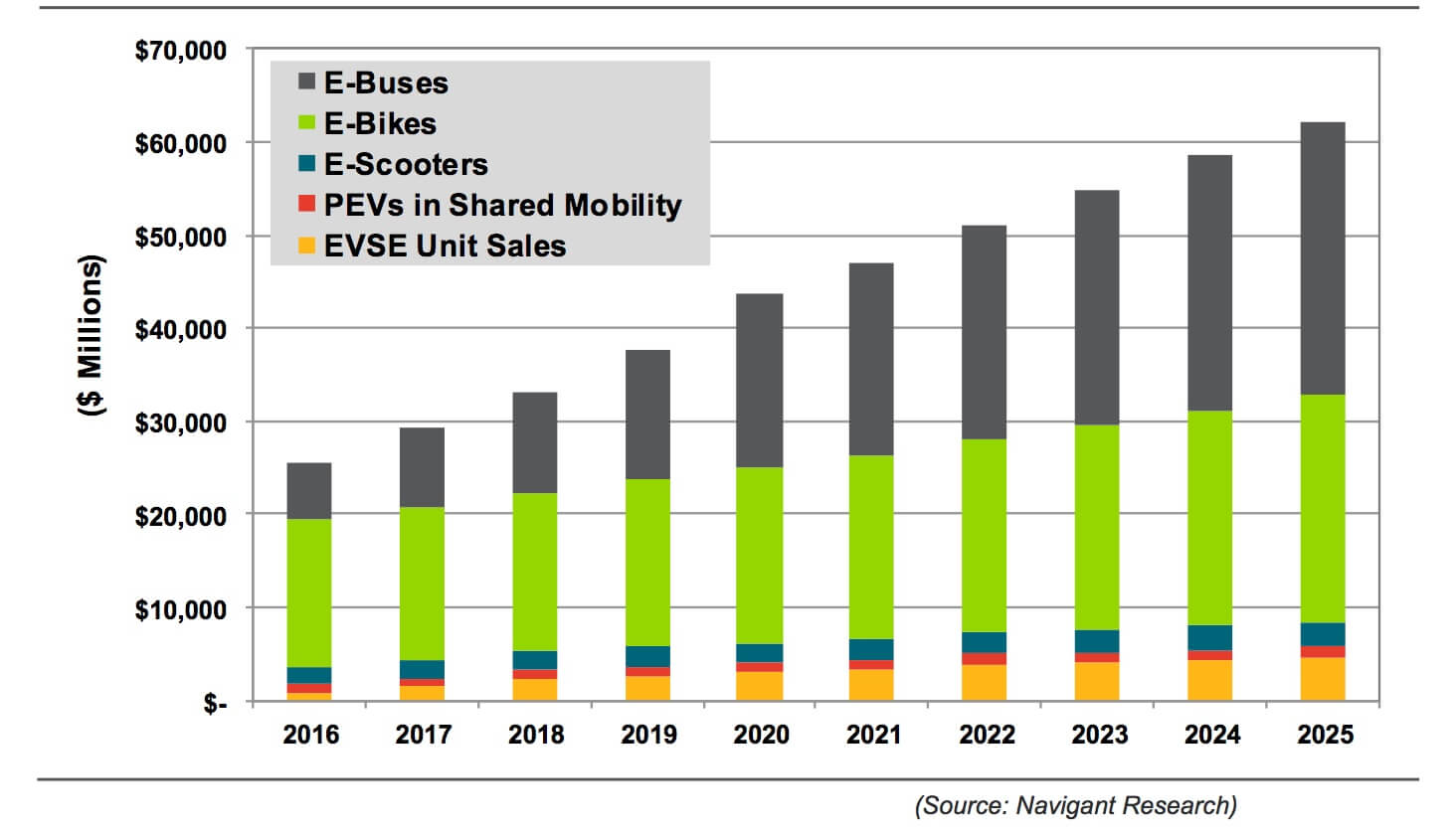
Global e-mobility market is set to reach $62.2 billion in annual revenue in 2025, according to the latest report from Navigant Research.
The primary technologies studied are electric buses (e-buses); electric-powered two-wheel (e-PTW) vehicles such as electric bicycles (e-bikes) and electric scooters (e-scooters); plug-in electric vehicles (PEVs) in shared mobility programs; and electric vehicle (EV) charging infrastructure. Unless EVs specifically address smart city mobility, such as PEVs used in carsharing services or neighborhood EV (NEV) programs, they are not analyzed in depth in this report.
Market Issues
Consumers around the globe are increasingly searching for new products and services that will enable improved mobility in and around city centers. Simultaneously, cities are strategizing on how to reduce traffic congestion and meet aggressive climate action plans. A key challenge for cities in the 21st century is how larger numbers of people can be incentivized to move away from personal cars for motorized transportation and toward cleaner mobility devices and services.
Electric mobility (e-mobility) devices are uniquely positioned to fill these voids and provide both consumers and city governments with a multitude of solutions. E-mobility devices reduce vehicle emissions and noise while improving personal mobility in cities—something personal EV ownership cannot achieve on its own. While EVs generally provide a cleaner form of energy over their gasoline counterparts, they do not inherently improve traffic congestion. However, if EVs are part of a carsharing or NEV program, they can solve both problems at the same time. E-buses have great potential to positively affect urban air quality since city buses mostly operate in dense urban centers. Although e-PTWs are still considered to be in the early adopter phase in the United States, they are commonly used as commuting devices in Asia Pacific and many Western European countries, displacing millions of cars from city roads every year.
All e-mobility devices are linked by one common technology: EV charging infrastructure. While charging requirements vary between different devices and technologies, they all need access to convenient, reliable, and affordable charging networks.
The e-mobility industry is driven by increased urbanization, improving battery technology, national e-mobility plans, and city energy policy. Nevertheless, low consumer awareness and gasoline prices, a lack of long-term city visions or strategies, and high purchase prices (compared to conventional technologies) are still restricting sales in some markets.
Market Forecasts
Revenue generated by global e-mobility devices is expected to more than double from 2016 to 2025, growing from a $25.6 billion market in 2016 to $62.2 billion by 2025. E-mobility device revenue is expected to grow at a strong compound annual growth rate (CAGR) of 10.3% throughout the forecast period.
While Asia Pacific holds enormous market share in terms of e-mobility device sales and e-mobility battery pack energy capacity, the region is significantly less dominant in terms of e-mobility device revenue (74% market share in 2016). Average purchase prices for all e-mobility technologies (particularly e-PTWs and e-buses) are much lower in Asia Pacific compared to North America and Europe. This results in a revenue picture that is more evenly distributed on a regional basis compared to annual unit device sales and
battery capacity.
E-PTWs are expected to account for 69% of e-mobility device revenue in 2016 (e-bikes 62% and e-scooters 7%). E-bus revenue is climbing quickly and is expected to surpass e-PTW revenue levels by 2022 due to vastly higher purchase prices. Meanwhile, E-PTWs are expected to see their market share of global e-mobility revenue shrink to 43% by 2025. Annual e-mobility device sales of higher priced e-mobility devices such as e-buses, PEVs in shared mobility services, and electric vehicle supply equipment (EVSE) units are expected to grow more quickly. EVSE unit sales are expected to grow at the quickest pace of any e-mobility device over the forecast period (20.4% CAGR).
Annual E-Mobility Device Revenue by Technology, World Markets: 2016-2025







